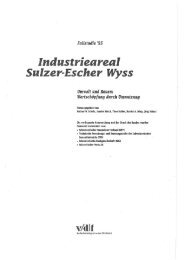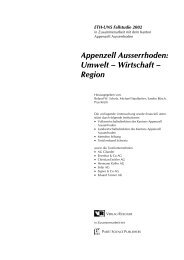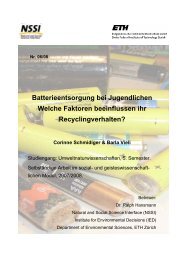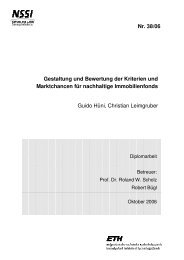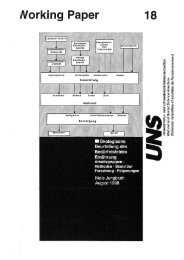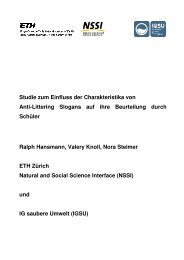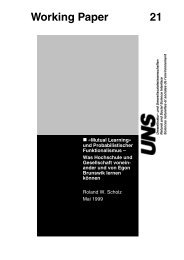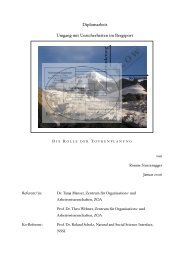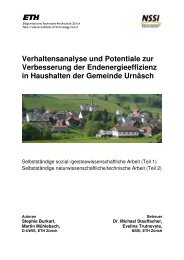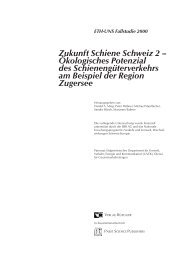The Paradigm of Human-Environment Systems - Natural and Social ...
The Paradigm of Human-Environment Systems - Natural and Social ...
The Paradigm of Human-Environment Systems - Natural and Social ...
You also want an ePaper? Increase the reach of your titles
YUMPU automatically turns print PDFs into web optimized ePapers that Google loves.
<strong>The</strong> <strong>Paradigm</strong> <strong>of</strong> <strong>Human</strong>-<strong>Environment</strong> <strong>Systems</strong><br />
Despite the fact that the medical doctors knew that cholera was an epidemic; their theories<br />
did not properly explain the mechanisms related to cholera prevention, cholera treatment<br />
<strong>and</strong> cholera dissemination. This is reflected in the large amount <strong>of</strong> strategies emerging <strong>and</strong><br />
being tested at that time (Goltz, 1998) 5 ..<br />
At the societal level the following options were available (see Shakespeare, 1890, pp. 819):<br />
(i) block <strong>of</strong>f (isolating) the city, (ii) designing disinfections programs for houses, (iii) placing city<br />
districts under quarantine, (iv) placing infected individuals under quarantine, (v) cleaning the<br />
“Ehgräben” 6 , <strong>and</strong> (vi) developing a sewage system. <strong>The</strong> individual had the following options: (i)<br />
leaving the city, (ii) participating in a group to keep the neighborhood clean, or (iii) refraining<br />
from leaving the house. Not considered in the strategy formation was for example boiling <strong>of</strong><br />
water.<br />
Strategy selection <strong>and</strong> action. Some <strong>of</strong> strategies were not chosen either because <strong>of</strong> ignorance<br />
or because <strong>of</strong> trade <strong>of</strong>fs with other issues. For example closing roads <strong>and</strong> cities had presumably<br />
stopped the spread <strong>of</strong> the disease, however, the dependence on foreign regions for<br />
supplies did force authorities to keep the city open to traffic (Brockhaus, 1865, Shakespeare,<br />
1890, p.820) 7 . This required compromises at a societal level. In Berlin, for example, 60 districts<br />
were defined each with a public health <strong>of</strong>ficer with executive police rights, an occurrence,<br />
which can be regarded as institutionalization (Deutsches Hygiene Museum, 1995). In addition,<br />
rooms <strong>and</strong> apartments were placed under quarantine.<br />
In Zürich, after the epidemic <strong>of</strong> 1854, the technology for cleaning the “Ehgräben” was im-<br />
ported from New York. <strong>The</strong> cleaning <strong>of</strong> the “Ehgräben“ was performed only early in the morn-<br />
ing or at night so that the odor could not “contaminate” other people. <strong>The</strong> gases coming out <strong>of</strong><br />
the Ehgräben were burned, or neutralized according to the knowledge <strong>of</strong> modern urban hygiene<br />
(Gesundheitsamt, p.9; Illi, 1987, p.77).<br />
<strong>Environment</strong>al reaction. <strong>The</strong> strategies chosen were obviously not sufficient. In Berlin,<br />
1,462 people died, among them Georg Friedrich Hegel in 1831. Between 1831 <strong>and</strong> 1933 the epidemic<br />
returned 13 times (Deutsches Hygiene Museum, 1995). In Zürich, the epidemic came back<br />
in 1865/66.<br />
Post-decisional evaluation/learning Exemplifying a post decisional learning process, the<br />
Miasma theory was not revisited in Zürich, but rather the strategies <strong>and</strong> actions were adapted.<br />
A sewage system was built, which collected the fecal matter from all households, transporting<br />
it to the river down stream from the city. From that point onwards, cholera was eradicated.<br />
5 For example, still in 1879, the prevalence <strong>of</strong> carbon dioxide was considered successful for preventing the genesis <strong>of</strong><br />
cholera (Kronser, 1879; Leary, 1998).<br />
6 Ehgräben were open canals at the border <strong>of</strong> the streets, where people dumped their excreta into, waiting for the<br />
rain to clean them away (Illi, 1987).<br />
7 This is a typical cost-benefit trade <strong>of</strong>f as modeled in decision theory.<br />
ETH-UNS Working Paper 37 15



